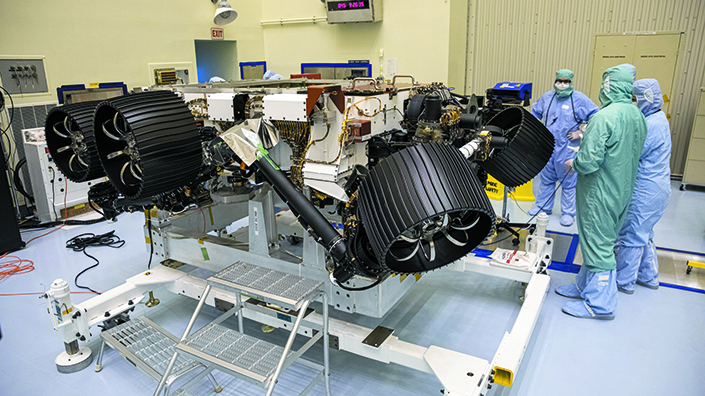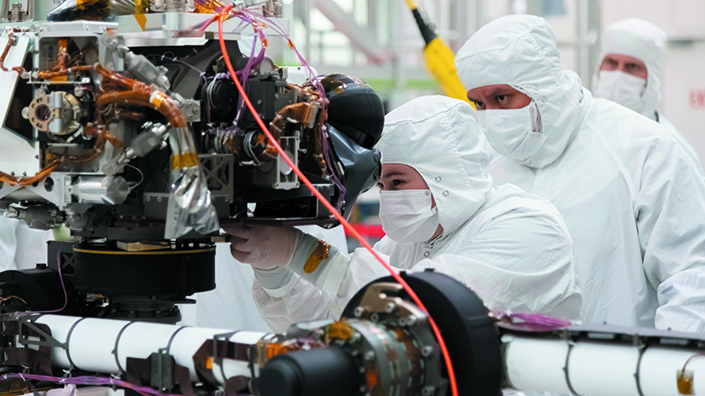Humanity’s understanding of the red planet has advanced significantly since Sojourner, the first of NASA’s robotic exploration rovers, touched down there in 1997.
Images captured before the landing indicated that there weren’t any little grey humanoids residing on the Martian surface. Upon closer inspection, nor did there even appear to be any less-complex creatures scurrying around. But there is some evidence to suggest that there were wet, Earth-like conditions on Mars billions of years ago. Such climates may have persisted long enough to support the development of microbial life.
If rovers were to unearth tiny fossils, or even traces of cells preserved in rocks, we could know that there was once other life in the universe. Humans have wondered about the existence of extraterrestrials for as long as we’ve observed the night sky. Finding traces of a Martian microorganism could satisfy this most intrinsic of curiosities. However, there are other, more strategic, reasons for dispatching robotic ambassadors to visit our planetary neighbour. Chief among them is to learn more about its atmosphere and geology so that we can prepare for eventual human exploration – and, with any luck, colonisation.
Trialling new technologies
In July, NASA will send its fifth rover, the car-sized Perseverance, to survey the state of the red planet. The mission will introduce a new drill that can collect and store samples of rocks and soils and stash them aside in a cache on the Martian surface. A future mission could subsequently ferry these specimens back to Earth for further analysis. The rover will also trial and demonstrate new technologies that could potentially be of use for future explorers, be they humans or robots.
Perseverance will embark on its journey equipped with seven instruments in total, among them an advanced pair of “eyes” for surveying the Martian surface and a suite of environmental sensors. Two zoomable cameras, known as Mastcam-Z, mounted on the rover’s “head”, will provide key visual data to allow scientists to select which rocks to study. The rover’s operators – who pre-plan each driving route and movement of its robotic arm – will view these stereo images through 3D goggles that will let them survey the Martian topography in detail.
The rover will also play host to the Mars Oxygen In-Situ Resource Utilisation Experiment (MOXIE), a demonstration project that aims to produce oxygen from Martian atmospheric CO2. If it’s successful, MOXIE’s technology could one day be used by astronauts on Mars to burn rocket fuel for the journey home to Earth. While much of Perseverance’s scientific hardware is new and novel, its fundamental design owes a lot to its predecessor: the Curiosity rover, launched in 2011. At roughly 10 feet long, 9 feet wide and 7 feet tall, the new vehicle shares the approximate dimensions of its older counterpart, although, at 1,025kg, Perseverance is 126kg heavier than Curiosity.
“We didn’t make incremental enhancements over Curiosity,” Rich Rieber, the lead mobility systems engineer for NASA’s Mars 2020 mission, told Professional Engineering. “We assumed the team had it right and we didn’t repeat their engineering. It’s a case of the better the devil you know. We know there are some problems with Curiosity, we know there are inefficiencies, but we know how to work with those.”
More robust wheels
While the rover is still operational and venturing around the planet long after the end of its two-year mission, it’s doing so atop some heavily rock-damaged wheels. NASA has known about these defects for several years, as Curiosity’s onboard cameras illustrated progression from dents to holes and cracks in the treads. Given Perseverance’s extra weight, Rieber and his colleagues realised its wheels would need a radical overhaul to make them more robust.
They started the redesign process by 3D printing around 70 different tyre designs, each with different tread (or grouser) properties. It took roughly a year and a half for engineers to figure out the optimum tread configuration: 48 gently curved grousers in place of Curiosity’s 24 chevron-patterned ones. Next, the prototypes had to undergo rigorous durability testing. The six wheels now fixed on Perseverance – and bound for Mars – are made of flight-grade aluminium and measure 52.5cm in diameter.

It took roughly one-and-a-half years to optimise the tread configuration (Credit: NASA/ JPL-Caltech)
“When the Curiosity team discovered the wheels were having problems, they assembled what we call a Tiger Team to study that problem,” says Rieber. “I’m proud to say that if you go back to the original parameters of damage that the Tiger Team set out for Curiosity, our wheels were tested over 60km and did not sustain a bit of damage per that definition. Looking at a graph that has no data on it is extremely boring, so we actually had to change the definition so we had something to measure.”
Navigation system
Another of Curiosity’s quirks is its slightly overcautious autonomous navigation system. If, for instance, the rover sees two rocks that it identifies as perilous, it will only choose to move between them if it has more than adequate space. Algorithms allow the robotic explorer to analyse the images it captures during a drive to calculate a safe passage for itself. This means that it can rove around beyond the area that human route planners on Earth have evaluated ahead of time.
“Curiosity’s designers treated the rover as a disc and created a 2.5m radius around the rover. That’s a 5m diameter circle in which there can be no hazards. That’s very conservative,” Rieber says. “We’ve overhauled our algorithm so it’s more aggressive compared to Curiosity. We’re estimating where each wheel will be and we have the rover think of each wheel as a box. At every 20cm interval along a potential drive arc, we evaluate where each wheel could be and we evaluate that wheel box for safety.”

The NASA team installs a sensor-filled turret on the end of the rover's robotic arm (Credit: NASA/ JPL-Caltech)
While each piece of Perseverance’s software and hardware has undergone a thorough series of tests here on Earth, there will always be some unknown factors lurking on the Martian surface. At this point, Rieber isn’t concerned about the rover’s physical ability to withstand the alien environment so much as its inbuilt algorithms’ capacity to respond to it. Every mechanical assembly that will make it to Mars has been tested in a thermal vacuum chamber in extreme hot and cold conditions. Components have also undergone atmospheric pressure tests and various worst-case structural experiments. A replica of the chassis, for instance, was placed in a centrifuge and subjected to extreme G-forces as part of its development. However, the rover’s automatic navigation algorithms will only face their greatest trial once the mission is already under way.
Overly conservative?
“We can’t perfectly recreate the Martian environment. We don’t have orbital imagery that can resolve 10-20cm sized rocks, so we don’t know where all the rocks are,” Rieber says. “We can’t iterate across an infinite amount of terrain types or terrain shape. We just need to develop a bunch of evidence that makes us feel confident in the algorithm. We know it’s going to be safe, the issue is whether it’s overly conservative in determining that something is unsafe.”
For now, the images and specimens captured by NASA’s rovers are the closest humans can get to touching Martian soil. With each new mission to the red planet, we learn more about its austere and hostile landscape. Just a few decades ago, the prospect of sending a robot to Mars to act as a proxy scientist would have seemed unthinkable. With the help of Perseverance and its predecessors, we can now imagine a day when there is (human) life on Mars.
Want the best engineering stories delivered straight to your inbox? The Professional Engineering newsletter gives you vital updates on the most cutting-edge engineering and exciting new job opportunities. To sign up, click here.
Content published by Professional Engineering does not necessarily represent the views of the Institution of Mechanical Engineers.